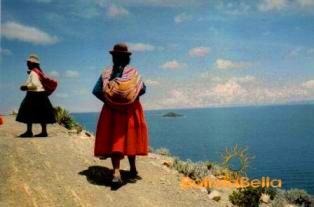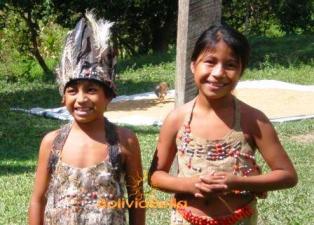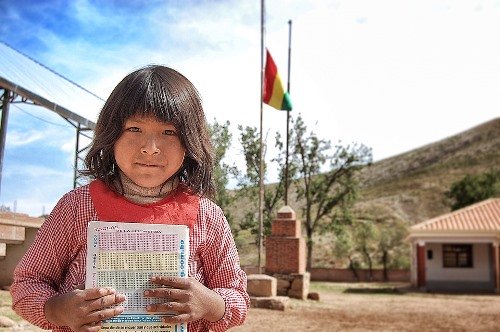|
Population of Bolivia and Demographics In Bolivia people are culturally, racially and socially diverse, a clear reflection of the over 36 native indigenous groups that have inhabited the country’s various regions for thousands of years, and a result of the historical assimilation of other races over time.
The following demographic data is based on 2006 and 2009 statistics and 2010 stats and projections. Bolivia is one of only three countries in Latin America whose largest population segment is comprised of Amerindians - the other two being Guatemala and Peru. In 2010 Bolivia's population grew to over 10 million.
Aymara and Quechua (2 million), Chiquitano (180,000) and Guaraní (125,000) are the four largest of Bolivia's nearly 30 indigenous ethnic groups. The great majority of European descendants are of Spanish origin, although fairly large German, North American and Italian communities exist as well. There are also smaller Asian, Middle Eastern, Japanese, Chinese, Korean, Jewish, Mennonite, Swiss, Dutch and other minority groups. Many of these families settled in Bolivia several generations ago. Bolivia also has a small Afrobolivian segment in the Yungas region, descendants of the few slaves brought from Africa. Bolivia is one of the least-developed countries in South America. Almost two-thirds of its people, many of whom are subsistence farmers, live in poverty. Population density ranges from 1 person per square kilometer in the far southeastern savannah region to about 10 per square kilometer in the Andes highlands. There is currently great migration to urban areas, especially Santa Cruz de la Sierra, Cochabamba and Tarija. See the 10 largest cities in Bolivia. See 100 famous people from Bolivia. Annual growth rate in July 2006 was estimated at 1.45% and in 2009 at about 2.2% Census According to Bolivia’s 2001 census, the country had approximately 8,858,000 inhabitants. However, a July 2006 estimate indicated it had increased to about 8,989,046 and a 2010 projection puts it at over 1.1 million. See a list of Bolivia's 36 cultures. 
Languages Until 2009 Spanish, Quechua, and Aymara were Bolivia's three official languages. However, as of December 2009, when Bolivia adopted a new national constitution, ALL native languages and dialects have been declared official languages. Spanish is used by the great majority of the population, although many of Bolivia's indigenous peoples are bilingual. Today Quechua and Aymara are still spoken throughout a large part of Bolivia and to a lesser degree you can also hear Guarani, Pano, and others. Although not official languages in Bolivia, the country also has very large foreign immigrant groups and it is not unusual to hear English, German, Japanese, Dutch, French, Norwegian, and other languages spoken. Religions The great majority of the population of Bolivia claims to be Roman Catholic (over 80%), although Protestant denominations (5%) are expanding strongly. Islam is practiced by the descendants of Middle Easterners, many of whom originated in Lebanon. There is also a small, yet influential Jewish community. More than 3 percent of Bolivians practice the Baha'í faith, giving Bolivia one of the largest percentages of Baha'í practitioners in the world. Due to extensive Mormon missionary efforts, there is a substantial Mormon demographic. There are also very large Mennonite colonies in Eastern Bolivia. Many indigenous communities interweave pre-Columbian and Christian symbols in their worship. Indigenous groups still live and practice their native beliefs, and tend to blend them with Roman Catholicism. Read more about Bolivia religion here. Cultural Development The cultural development of present-day Bolivia is divided into three distinct periods: pre-Colombian, colonial, and republican. Important archeological ruins, gold and silver ornaments, stone monuments, ceramics, and weavings remain from several important pre-Columbian cultures. Major ruins include Tiahuanaco, Samaipata, Incallajta, and Iskanwya. There are many more archeological sites that are yet to be explored. 
Literacy (definition: age 15 and over can read and write) total literate population: 87.2%. The literacy rate tends to be much lower in some rural areas. Approximately 90% of children attend primary school, but some for only a year or two. Less than 35% of Bolivia's population graduates from high school, and even fewer attend universities. Bolivia's distinctive topography and ecology have had an enduring impact on settlement patterns. They also have figured in the relations among the country's diverse groups because of the isolation most communities and regions faced until at least the 1950s. Bolivia is undergoing extensive migration at the time. Some traditionally populous regions are losing inhabitants quickly while others are receiving them in record numbers and experiencing phenomenal growth. These are now the major cities of Bolivia. Population: The 2001 census in Bolivia counted 8,274,325 inhabitants, of which 62% over the age of 15 identified themselves with an indigenous peoples. A 2010 projection puts the population at just over 10.1 million. Bolivia's population is made up of native indigenous peoples who occupied areas of the current national territory for hundreds (in some cases thousands) of years prior to the arrival of the Spanish in 1534 and other Europeans, Africans and Asians thereafter. Most of the portion of Bolivia's population that identifies itself as "indigenous" is actually mestizo "mixed race". Indigenous groups are either from the Andean peoples, including the Aymara and Quechua, or the Eastern lowlands peoples, among which are the Chiquitanos, Guarani, Moxeño, Movida, Guarayos, Ayoreos, Trinidad, and several dozen other cultures from the Amazon tropics. Many Bolivians are descendants of Europeans who arrived from Spain during the colonization between the 1500's and early 1800's. During the industrial revolution in the 1800's many German and Italian immigrants arrived. In the early 1900's, due to political changes in the area, Croats, Hungarians, Turks, Jewish, and Palestinians migrated to Bolivia. And after World War II, mostly during the early 1950's, many Japanese colonists arrived as well. Bolivia has a very small number of African-Bolivians, most of whom reside in the Yungas region. They were brought over during the Slave Trade era by the Spanish from Congo and Angola.     |
